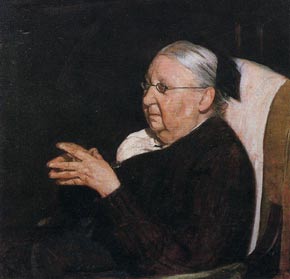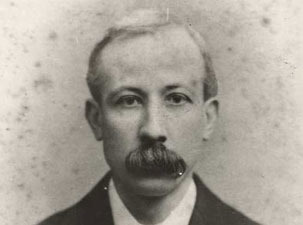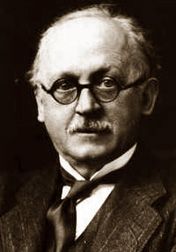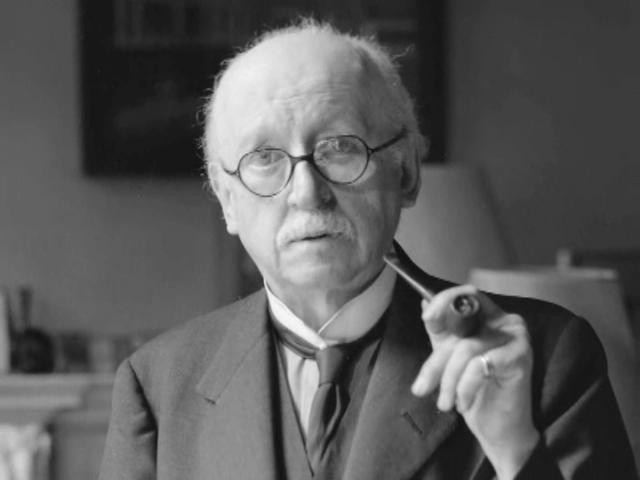<Back to Index>
- Horticulturalist and Garden Designer Gertrude Jekyll, 1843
- Architect and Architectural Historian William Richard Lethaby, 1857
- Architect Edwin Landseer Lutyens, 1869
PAGE SPONSOR

Gertrude Jekyll (29 November 1843 - 8 December 1932) was an influential British horticulturist, garden designer, artist and writer. She created over 400 gardens in the United Kingdom, Europe and the United States, and wrote over 1,000 articles for to Country Life magazine, The Garden and other magazines. Jekyll has been described as "a premier influence in garden design" by English and American gardening enthusiasts.
Jekyll was born at 2 Grafton Street, Mayfair, London, the fifth of the seven children of Captain Edward Joseph Hill Jekyll, an officer in the Grenadier Guards, and his wife Julia Hammersley. Her younger brother, the Reverend Walter Jekyll, was a friend of Robert Louis Stevenson, who borrowed the family name for his famous novella Dr Jekyll and Mr Hyde. In 1848 her family left London and moved to Bramley House, Surrey, where she spent her formative years.
Jekyll was one half of one of the most influential and historical partnerships of the Arts and Crafts movement, thanks to her association with the English architect, Sir Edwin Lutyens, for whose projects she created numerous landscapes, and who designed her home Munstead Wood, near Godalming in Surrey. (In 1900, Lutyens and Jekyll's brother Herbert designed the British Pavilion for the Paris Exposition.)
Jekyll is remembered for her outstanding designs and subtle, painterly approach to the arrangement of the gardens she created, particularly her "hardy flower borders". Her work is known for its radiant color and the brush - like strokes of her plantings; it is suggested by some that the Impressionistic style schemes may have been due to Jekyll's deteriorating eyesight, which largely put an end to her career as a painter and watercolorist. In works like Colour Schemes for the Flower Garden (reprinted 1988) she put her imprint on modern uses of "warm" and "cool" flower colors in gardens.
Jekyll was one of the first of her profession to take into account the color, texture, and experience of gardens as the prominent authorities in her designs, and she was a lifelong fan of plants of all genres. Her theory of how to design with color was influenced by painter J.M.W. Turner and by impressionism, and by the theoretical color wheel. Later in life, Jekyll collected and contributed a vast array of plants solely for the purpose of preservation to numerous institutions across Britain. This pure passion for gardening was started at South Kensington School of Art, where she fell in love with the creative art of planting, and even more specifically, gardening. At the time of her death, she had designed over 400 gardens in Britain, Europe and a few in North America. Jekyll was also known for her prolific writing. She penned over fifteen books, ranging from Wood and Garden and her most famous book Colour in the Flower Garden, to memoirs of her youth. Jekyll did not want to limit her influence to teaching the practice of gardening, but to take it a step further to the quiet study of gardening and the plants themselves. Her concern that plants should be displayed to best effect even when cut for the house, led her to design her own range of glass flower vases.
Jekyll later returned to her childhood home in the village of Bramley, Surrey to design a garden in Snowdenham Lane called Millmead. She was also interested in traditional cottage furnishings and rural crafts, and concerned that they were disappearing. Her book Old West Surrey (1904) records many aspects of 19th century country life, with over 300 photographs taken by Jekyll.
The "Gertrude Jekyll's Garden" is an early 20th century garden surrounding the Manor House at Upton Grey in the English county of Hampshire.
Gertrude Jekyll drew plans for a four and a half acre garden at the Manor House in Upton Grey in 1907. On this site she drew up one of her most picturesque gardens. It includes many features of a typical Jekyll garden but is much smaller scale than the majority of her other commissions.
To the west of the house is the Wild garden. Some of Jekyll's original drifts of daffodils remain at the end of the Wild Garden, still in the drifts she designed.
To the east of the house stands there is the formal garden. Here there are no curved lines, Jekyll designed a Rose Lawn and typical herbaceous borders whose colors run in drifts from cool to hot and the return to cool again. These, with the tennis and bowling lawns are enclosed in yew hedging.
Outside the hedging lies the nuttery, orchard, kitchen garden, stable cottage and cottage beds.
The whole of the garden has been faithfully restored to the many plans and plants that Jekyll prescribed. The garden fell into disrepair and was only restored in 1986. It may be visited by appointment only.
Jekyll was awarded the Veitch Memorial Medal and the Victoria Medal of Honour from the Royal Horticultural Society.
Jekyll is buried in the churchyard of Busbridge Church, formerly known as St. John the Baptist, Busbridge, Godalming, next to her brother and sister - in - law, Sir Herbert Jekyll, KCMG and Lady Agnes Jekyll, DBE. The monument was designed by Sir Edwin Lutyens.

William Richard Lethaby (18 January 1857 - 17 July 1931) was an English architect and architectural historian whose ideas were highly influential on the late Arts and Crafts and early Modern movements in architecture, and in the fields of conservation and art education.
Lethaby was born in Barnstaple, Devon, the son of a fiercely Liberal craftsman and lay preacher. After an early apprenticeship with a local architect he found work in London in 1879 as Chief Clerk to architect Richard Norman Shaw. Shaw quickly recognized Lethaby's talent as a designer and Lethaby was to contribute significant pieces of work to major Shaw - designed buildings such as Scotland Yard in London and Cragside in Northumberland.
While working for Shaw, Lethaby became involved in the Society for the Protection of Ancient Buildings, which campaigned to preserve the integrity and authenticity of older buildings against the Victorian practice of 'improving' them to the point of almost completely rebuilding and redesigning them. Through this he became a personal friend of Arts and Crafts Movement pioneers William Morris and Philip Webb, becoming a significant and influential member of their circle and acting as co-founder of the Art Workers Guild in 1884.
The Guild was formed from a nucleus drawn from two separate groups, the St George’s Art Society, a group of architects who had seen service in the offices of Norman Shaw, including Ernest Newton, Mervyn Macartney, Reginald Barratt, Edwin Hardy, Lethaby and Edward Schroeder Prior, and the Fifteen, founded by the designer and writer Lewis Day and the illustrator and designer Walter Crane. Prior wrote the prospectus for the Guild. It initially met in Newton’s chambers by St George’s Church, Bloomsbury.
From 1889 Lethaby worked only part time for Shaw and increasingly practiced independently, designing a wide range of products - books, furniture and stained glass as well as buildings - exploring the mystical symbolism of medieval and non - European design and architecture: themes he was to elaborate in his first and most famous (though arguably least representative) book Architecture, Mysticism, and Myth, published in 1891. This was the first major work of architectural theory to treat architecture as a system of symbols with identifiable philosophical meanings, rather than as abstract systems of aesthetic principles.
Lethaby finally left Shaw's practice in 1892 after the completion of his first major independent architectural project - the country estate of Avon Tyrrell in Hampshire, built for Lord Manners. The next decade was Lethaby's most productive in terms of built works as his contacts in the Birmingham area, where the ideas of the arts and crafts movement were particularly well received, led to series of commissions for buildings in the Midlands or for Birmingham based clients. He built Monkswood Cottage, Loughton, Essex, for his friend, Hubert Llewellyn Smith.
In 1894 Lethaby was appointed Art Inspector to the Technical Education Board of the newly formed London County Council. Here he had a pioneering role in developing education in the fine and practical arts, most notably as the founder of the Central School of Arts and Crafts in 1896. His most significant innovations lay in breaking down academic barriers between design (perceived as an artistic and intellectual pursuit) and production (widely perceived as the less sophisticated activity of the craftsman or artisan). Lethaby believed that this was an artificial distinction and sought to have both taught as equally valuable parts of the process of producing a high quality end product.
In 1901 Lethaby was appointed the first Professor of Design at the Royal College of Art. This, coupled with his appointments as Principal of the Central School of Arts and Crafts in 1902 and as Surveyor of Westminster Abbey in 1906 meant that he was increasingly devoted to the academic study of the theory and history of architecture and design. He effectively ceased architectural practice around this time, though he remained an immensely influential figure through his writings and teaching. Lethaby's role as a guide and mentor to German Cultural Attaché Hermann Muthesius during his investigations into English architecture was to prove particularly significant in the light of Muthesius's later role as an influence on the early pioneers of the Bauhaus.
At Westminster Abbey, Lethaby was able to put into practice his belief in sympathetic and historically accurate restoration, conducting extensive research into the history of its structure and design and largely setting the template that the restoration and preservation of historic buildings was to follow for the rest of the century.
Lethaby has traditionally been seen by figures such as Nikolaus Pevsner as significant primarily in his role as a precursor of the early modern movement. He was the acknowledged theorist behind the work of Ernest Gimson and the group of architect - craftsmen who worked with him in Sapperton, Gloucestershire, intent to found a "school of rational building". Lethaby's emphasis on "good, honest building" is viewed as making explicit the functionalism implicit in the writings and architecture of Pugin, Ruskin and Philip Webb, with his connection to Muthesius as the means through which this idea was to influence the German modernist pioneers.
More recently it has been argued that this represents a considerable over - simplification of Lethaby's complex and sometimes contradictory sets of beliefs. "A house should be as efficient as a bicycle" may presage Le Corbusier, but Lethaby's theories of meaning in architecture and his use of elemental, cosmological and mystical symbolism in his design work can be seen as having more in common with post modern figures such as Charles Jencks.
Either way, Lethaby remains widely recognized as a figure of pivotal significance in the transition between the architecture of the nineteenth and twentieth centuries.


Sir Edwin Landseer Lutyens, OM, KCIE, PRA, FRIBA (29 March 1869 – 1 January 1944) was a British architect who is known for imaginatively adapting traditional architectural styles to the requirements of his era. He designed many English country houses.
He has been referred to as "the greatest British architect" and is known best for having an instrumental role in designing and building a section of the metropolis of Delhi, known as New Delhi, which would later on serve as the seat of the Government of India. In recognition of his contribution, New Delhi is also known as "Lutyens' Delhi". In collaboration with Herbert Baker, he was also the main architect of several monuments in New Delhi such as the India Gate; he also designed the Viceroy's House now known as the Rashtrapati Bhavan.
He was born in London and grew up in Thursley, Surrey, the son of Charles Henry Augustus Lutyens and Mary Theresa Gallwey. He was named after a friend of his father's, the painter and sculptor Edwin Henry Landseer. For many years he worked from offices at 29 Bloomsbury Square, London. Lutyens studied architecture at South Kensington School of Art, London from 1885 to 1887. After college he joined the Ernest George and Harold Peto architectural practice. It was here that he first met Sir Herbert Baker.
He began his own practice in 1888, his first commission being a private house at Crooksbury, Farnham, Surrey. During this work, he met the garden designer and horticulturalist Gertrude Jekyll. In 1896 he began work on a house for Jekyll at Munstead Wood, Godalming, Surrey. It was the beginning of a professional partnership that would define the look of many Lutyens country houses.
The "Lutyens - Jekyll" garden overflowed with hardy shrubbery and herbaceous plantings within a firm classicizing architecture of stairs and balustraded terraces. This combined style, of the formal with the informal, exemplified by brick paths, softened by billowing herbaceous borders, full of lilies, lupins, delphiniums, and lavender was in direct contrast to the very formal bedding schemes favored by the previous generation in the 19th century. This new "natural" style was to define the "English garden" until modern times.
Lutyens' fame grew largely through the popularity of the new lifestyle magazine Country Life created by Edward Hudson, which featured many of his house designs. Hudson was a great admirer of Lutyens' style and commissioned Lutyens for a number of projects, including Lindisfarne Castle and the Country Life headquarters building in London, at 8 Tavistock Street. One of his assistants in the 1890s was Maxwell Ayrton.
Initially, his designs were all Arts and Crafts style, a good example being Overstrand Hall Norfolk and Le Bois des Moutiers (1898) in France, but during the early 1900s his work became more classical in style. His commissions were of a varied nature from private houses to two churches for the new Hampstead Garden Suburb in London to Julius Drewe's Castle Drogo near Drewsteignton in Devon and on to his contributions to India's new imperial capital, New Delhi, (where he worked as chief architect with Herbert Baker and others). He also designed a Columbarium for the Hannen family in Wargrave. Here he added elements of local architectural styles to his classicism, and based his urbanization scheme on Mughal water gardens. He also designed the Hyderabad House for the last Nizam of Hyderabad, as his Delhi palace.
He also designed a chalk building, Marsh Court, in Hampshire, England. Built between 1901 and 1905, it is the last of his Tudor designs and was based on a variant of ancient rammed earth building techniques. In 1903 the main school building of Amesbury Prep School in Hindhead, Surrey, was designed and built as a private residence. It is now a Grade 2* listed building of National Significance.
Before the end of World War I, he was appointed one of three principal architects for the Imperial War Graves Commission and was involved with the creation of many monuments to commemorate the dead. Larger cemeteries have a Stone of Remembrance, designed by Sir Edwin Lutyens. The best known of these monuments are the Cenotaph in Whitehall, Westminster, and the Memorial to the Missing of the Somme, Thiepval. The Cenotaph was originally commissioned by David Lloyd George as a temporary structure to be the centerpiece of the Allied Victory Parade in 1919. Lloyd George proposed a catafalque, a low empty platform, but it was Lutyens' idea for the taller monument. The design took less than six hours to complete. Many local war memorials (such as the one at All Saints', Northampton), Montréal, Quebec, Toronto, Ontario, Hamilton, Ontario, Victoria, British Columbia, and Vancouver, British Columbia are Lutyens designs — based on the Cenotaph. He also designed the War Memorial Gardens in Dublin, which were restored in the 1990s. Other works include the Tower Hill memorial, and (similar to his later India Gate design) a memorial in Victoria Park in Leicester. Lutyens also refurbished Lindisfarne Castle for its wealthy owner.
He was knighted in 1918 and was elected a Fellow of the Royal Academy in 1921. In 1924, he was appointed a member of the newly created Royal Fine Art Commission, a position he held until his death.
While work continued in New Delhi, Lutyens continued to receive other commissions including several commercial buildings in London and the British Embassy in Washington, DC.
In 1924 he completed the supervision of the construction of what is perhaps his most popular design: Queen Mary's Dolls' House. This four - storey Palladian villa was built in 1/12 scale and is now a permanent exhibit in the public area of Windsor Castle. It was not conceived or built as a plaything for children; its goal was to exhibit the finest British craftsmanship of the period.
Lutyens was commissioned in 1929 to design a new Roman Catholic cathedral in Liverpool. He planned a vast building of brick and granite, topped with towers and a 510 foot dome, with commissioned sculpture work by Charles Sargeant Jagger and W.C.H. King. Work on this magnificent building started in 1933, but was halted during the Second World War. After the war, the project ended due to a shortage of funding, with only the crypt completed. A model of Lutyens' unrealized building was given to and restored by the Walker Art Gallery in 1975 and is now on display in the Museum of Liverpool. The architect of the present Liverpool Metropolitan Cathedral, which was built over land adjacent to the crypt and consecrated in 1967, was Sir Frederick Gibberd.
In 1945, a year after his death, A Plan for the City & County of Kingston upon Hull was published. Lutyens worked on the plan with Sir Patrick Abercrombie and they are credited as its co-authors. Abercrombie's introduction in the plan makes special reference to Lutyens' contribution. The plan was, however, rejected by the City Council of Hull.
Largely designed by Lutyens over twenty or so years (1912 to 1930), New Delhi, situated within the metropolis of Delhi, was chosen to replace Calcutta as the seat of the British Indian government in 1912; the project was completed in 1929 and officially inaugurated in 1931. In undertaking this project, Lutyens invented his own new order of classical architecture, which has become known as the "Delhi Order" and was used by him for several designs in England, such as Campion Hall, Oxford. Unlike the more traditional British architects who came before him, he was both inspired by and incorporated various features from the local and traditional Indian architecture — something most clearly seen in the great drum mounted Buddhist dome of the Viceroy's House, now Rashtrapati Bhavan. This palatial building, containing 340 rooms, is built on an area of some 330 acres (1.3 km2) and incorporates a private garden also designed by Lutyens. The building was designed as the official residence of the Viceroy of India and is now the official residence of the President of India.
The "Delhi Order" columns at the front entrance of the palace have bells carved into them, which, it has been suggested, Lutyens had designed with the idea that as the bells were silent the British rule would never come to an end. At one time, more than 2,000 people were required to care for the building and serve the Viceroy's household.
The new city contains both the Parliament buildings and government offices (many designed by Herbert Baker) and was built distinctively of the local red sandstone using the traditional Mughal style.
When composing the plans for New Delhi, Lutyens planned for the new city to lie southwest of the walled city of Shahjahanbad. His plans for the city also laid out the street plan for New Delhi consisting of wide tree lined avenues.
Built in the spirit of British colonial rule, the place where the new imperial city and the older native settlement met was intended to be a market; it was there that Lutyens imagined the Indian traders would participate in "the grand shopping center for the residents of Shahjahanabad and New Delhi", thus giving rise to the D-shaped market seen today.
Many of the garden-ringed villas in the Lutyens' Bungalow Zone (LBZ) — also known as Lutyens' Delhi — that were part of Lutyens' original scheme for New Delhi are under threat due to the constant pressure for development in Delhi. The LBZ was placed on the 2002 World Monuments Fund Watch List of 100 Most Endangered Sites. It should be noted that none of the bungalows in the LBZ were designed by Lutyens — he only designed the four bungalows in the Presidential Estate surrounding Rashtrapati Bhavan at Willingdon Crescent now known as Mother Teresa Crescent. Other buildings in Delhi that Lutyens designed include Baroda House, Bikaner House, Hyderabad House, Jaipur House and Patiala House.
Lutyens was made a Knight Commander of the Order of the Indian Empire (KCIE) on 1 January 1930. A bust of Lutyens in the former Viceroy's House is the only statue of a Westerner left in its original position in New Delhi. Lutyens' work in New Delhi is the focus of Robert Grant Irving's book Indian Summer.
Works in Ireland include the Irish National War Memorial Gardens in Islandbridge Dublin, which consists of a bridge over the railway and a bridge over the river Liffey (unbuilt) and two tiered sunken gardens; Heywood Gardens, County Laois (open to the public) consisting of a hedge garden, lawns, tiered sunken garden and a belvedere; extensive changes and extensions to Lambay Castle, Lambay Island near Dublin consisting of a circular battlement enclosing the restored and extended castle and farm building complex, upgraded cottages and stores near the harbor, a real tennis court, a large guest house (The White House), a boathouse and a chapel; alterations and extensions to Howth Castle, County Dublin; the unbuilt Hugh Lane gallery straddling the River Liffey on the site of the Ha'penny Bridge and the unbuilt Hugh Lane Gallery on the west side of St Stephen's Green; a Lodge at Costelloe, County Galway (that was used for refuge by J Bruce Ismay the Chairman of the White Star Line following the sinking of the Titanic) and a hunting lodge near Rosapenna in northern County Donegal, most recently used as a youth hostel.
In Northern Ireland, he is attributed as architect of Stormont House, Belfast, designed as a home for the Speaker of the Parliament of Northern Ireland.
In Madrid he worked in the reconstruction of Liria Palace, which was severely damaged by the Francoist troops during the Spanish civil war. The works were commissioned by the Duke of Alba Jacobo Fitz - James Stuart y Falcó, who had met Lutyens while he was the Spanish ambassador to Great Britain. The palace is a neoclassical building by architect Ventura Rodriguez, it was commissioned by the I Duke of Berwick and Liria James Fitz - James at the service of King Philip V of Spain.
Two years after she proposed to him and in the face of parental disapproval, Lady Emily Bulwer - Lytton (1874 – 1964), third daughter of Edward Bulwer - Lytton the 1st Earl of Lytton, a former Viceroy of India, and Edith Villiers, married Lutyens on 4 August 1897 at Knebworth, Hertfordshire. They had five children, but the union was largely unsatisfactory, practically from the start. The Lutyens' marriage quickly deteriorated, with Lady Emily becoming interested in theosophy, Eastern religions and a fascination — emotional and philosophical — with Jiddu Krishnamurti.
The couple's daughter Elisabeth Lutyens became a well known composer; another daughter, Mary Lutyens, became a writer known for her books about Krishnamurti. A grandson was Nicholas Ridley, cabinet minister under Margaret Thatcher.
During the later years of his life, Lutyens suffered with several bouts of pneumonia. In the early 1940s he was diagnosed with cancer. He died on 1 January 1944. His memorial, designed by his friend and fellow architect William Curtis Green, is in the crypt of St. Paul's Cathedral, London.